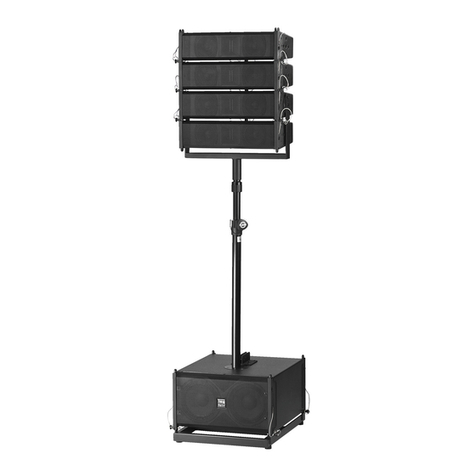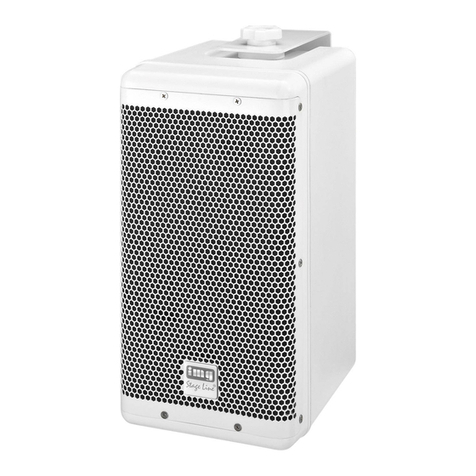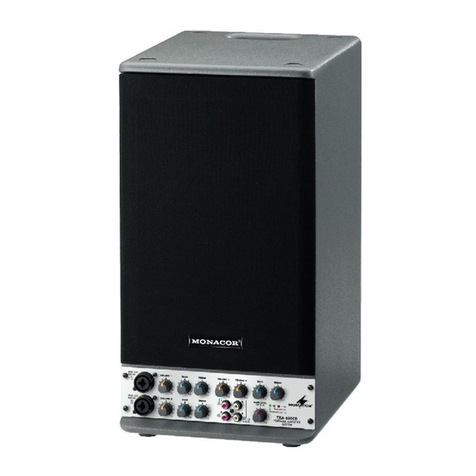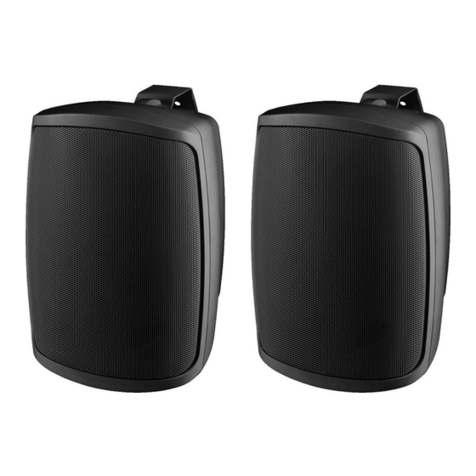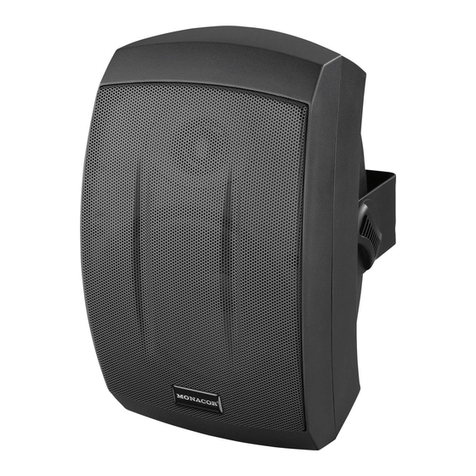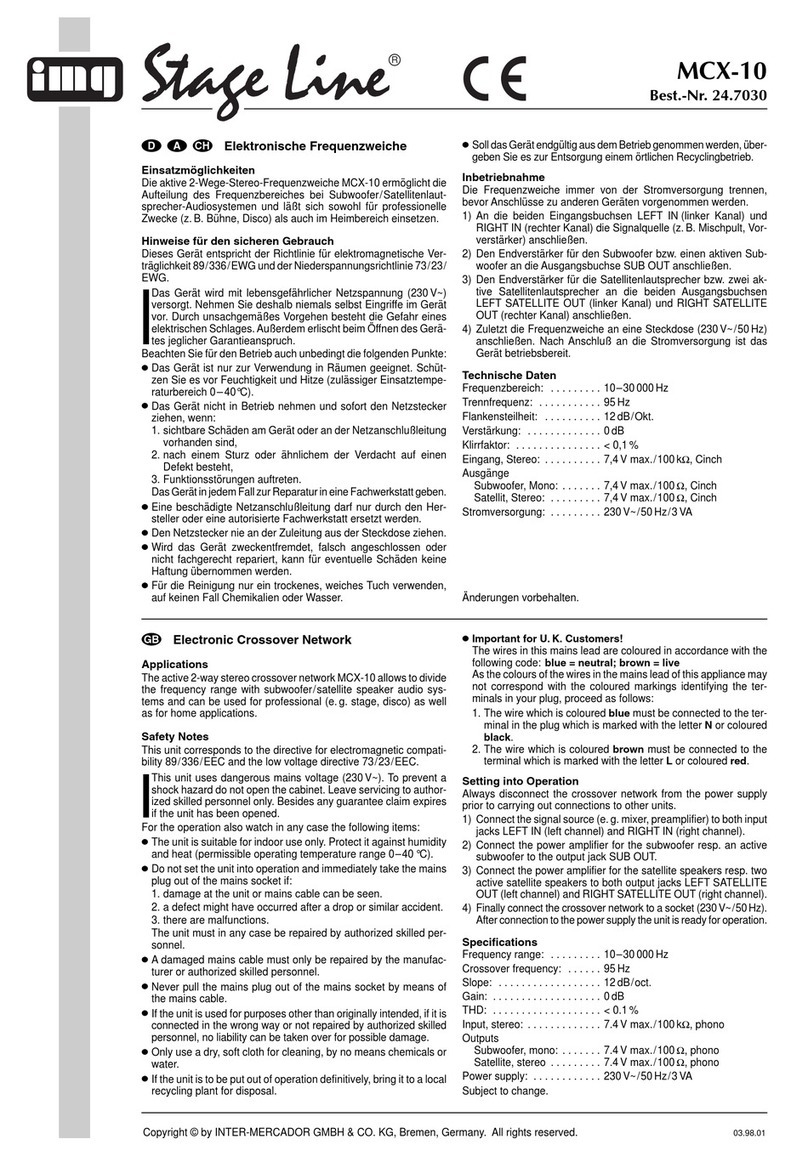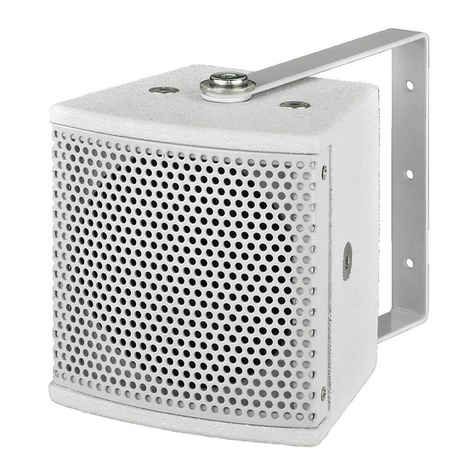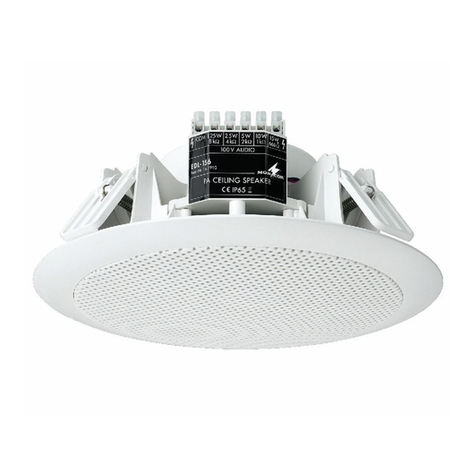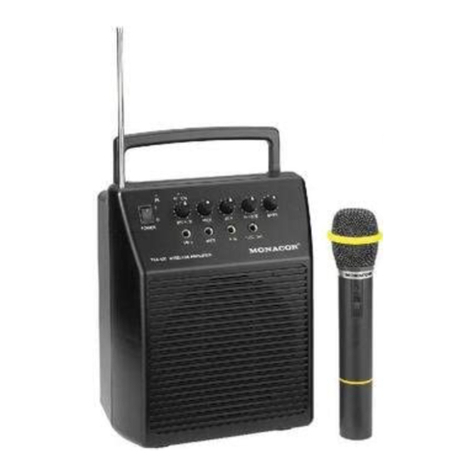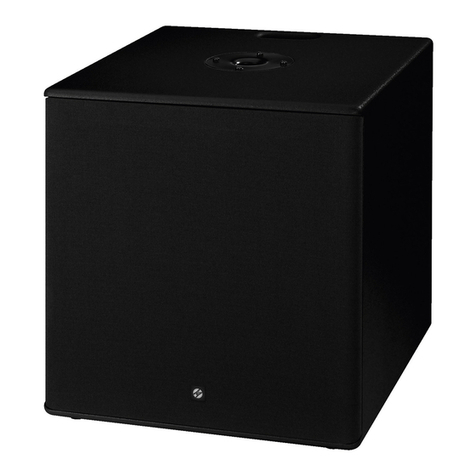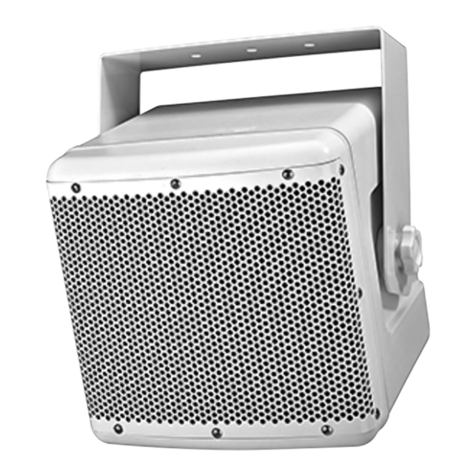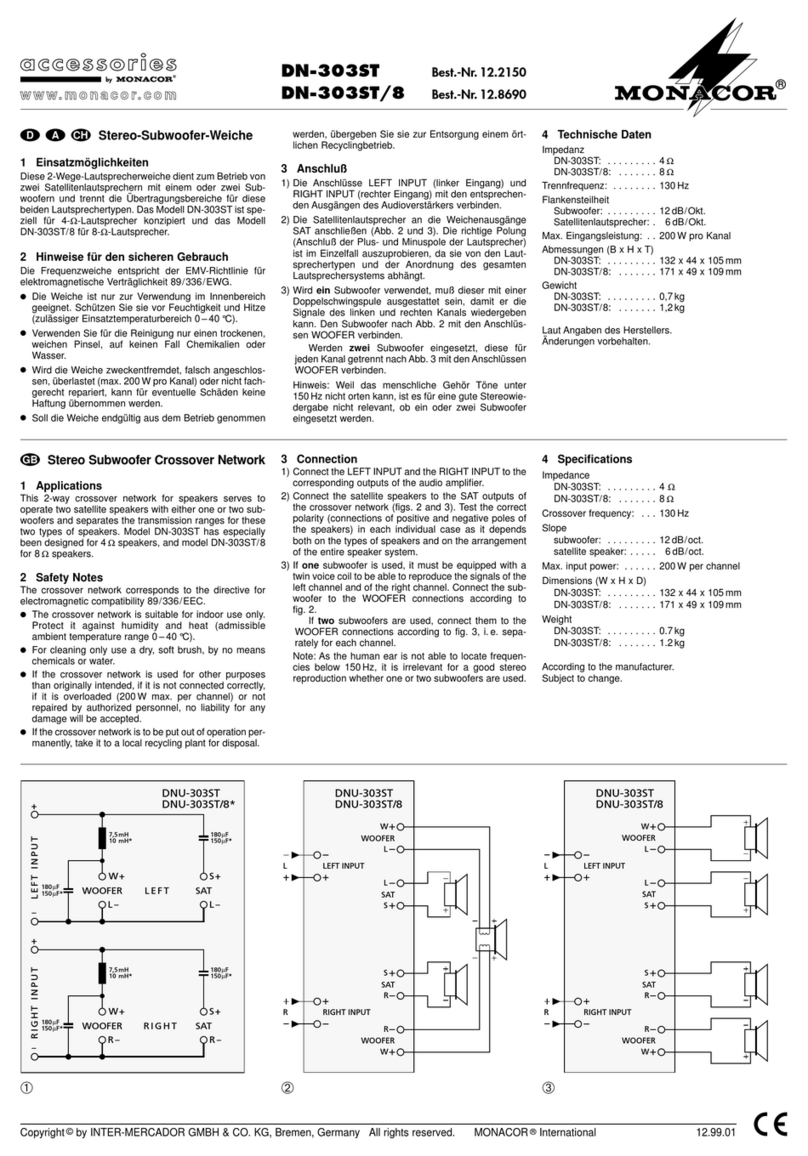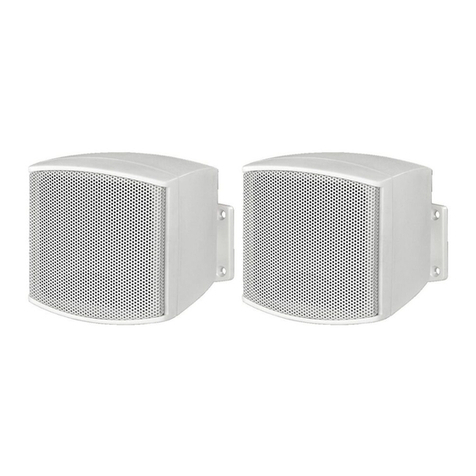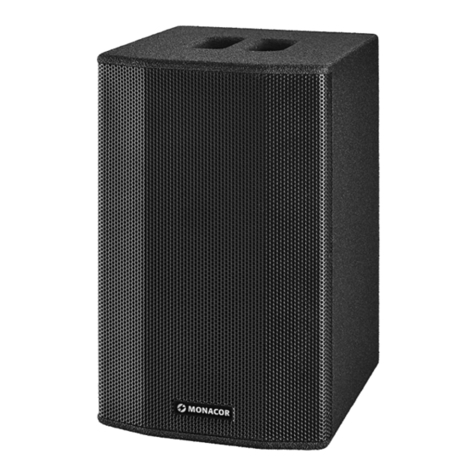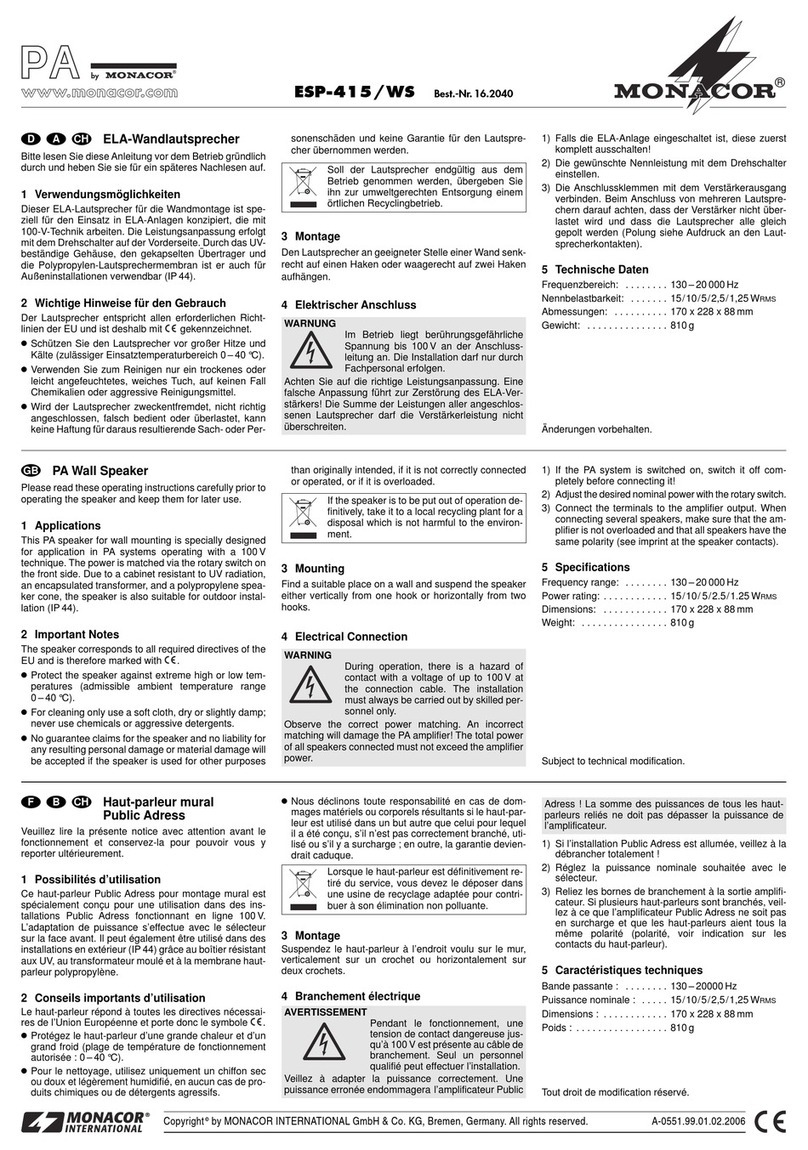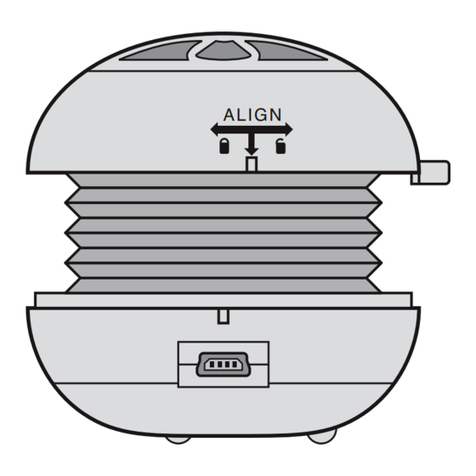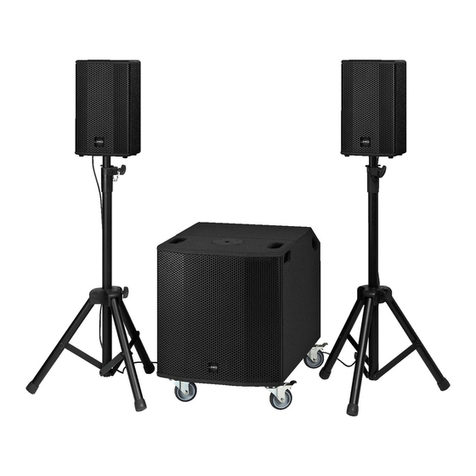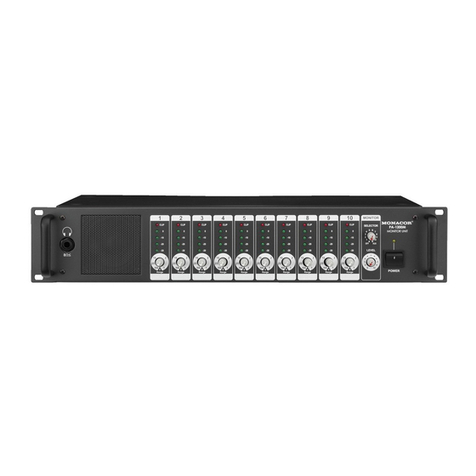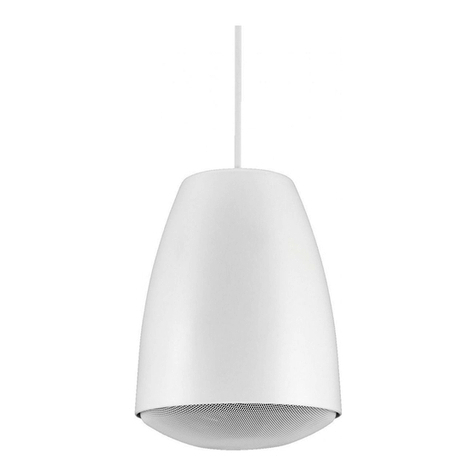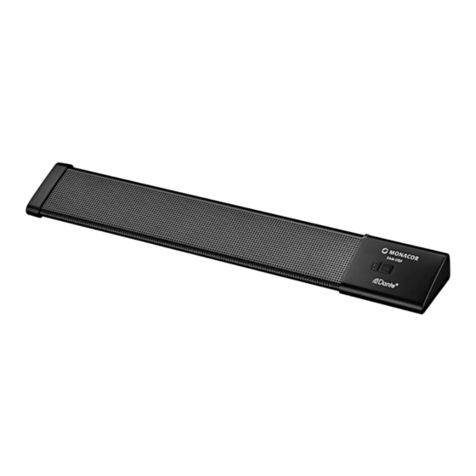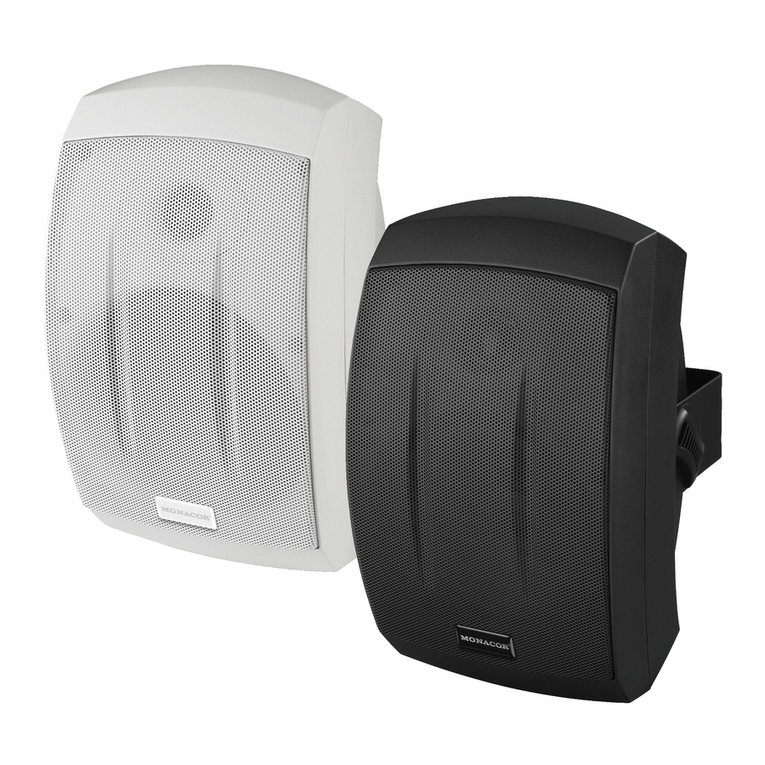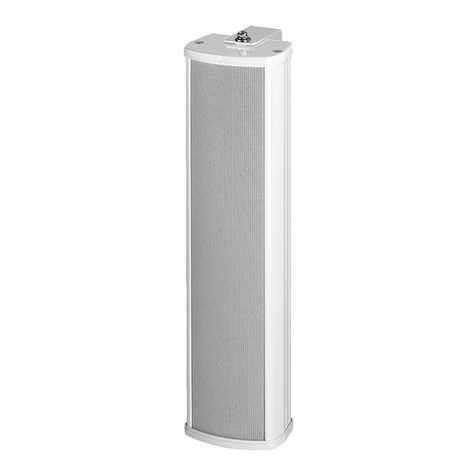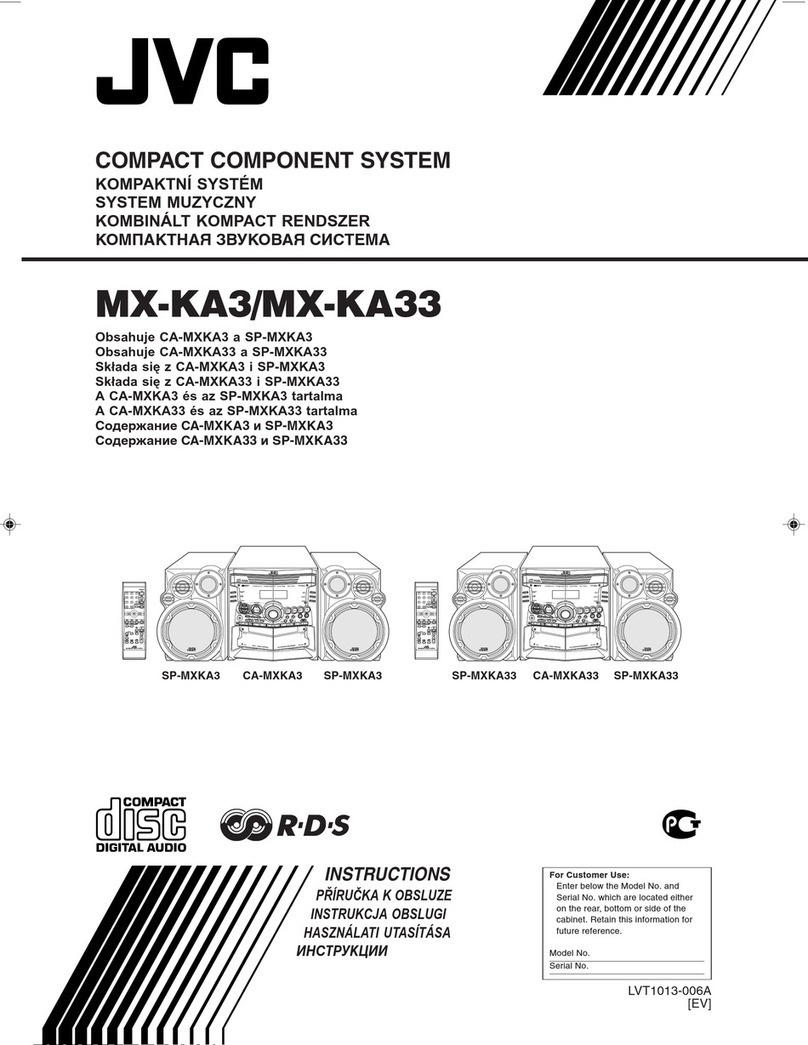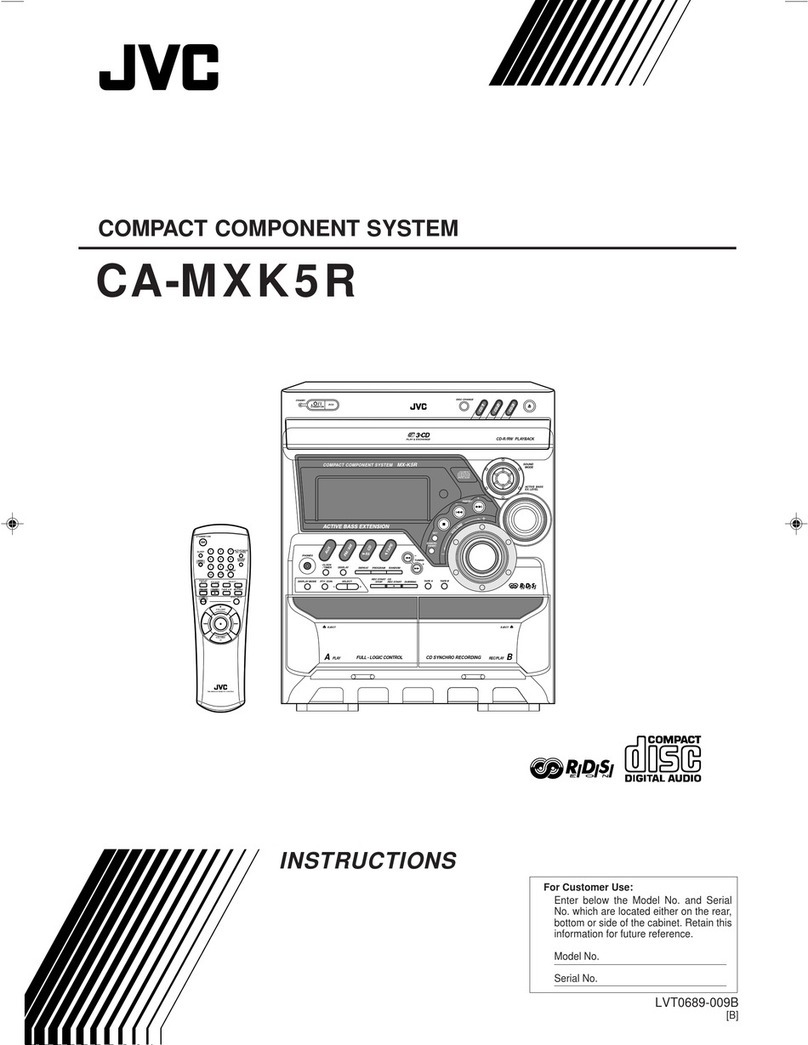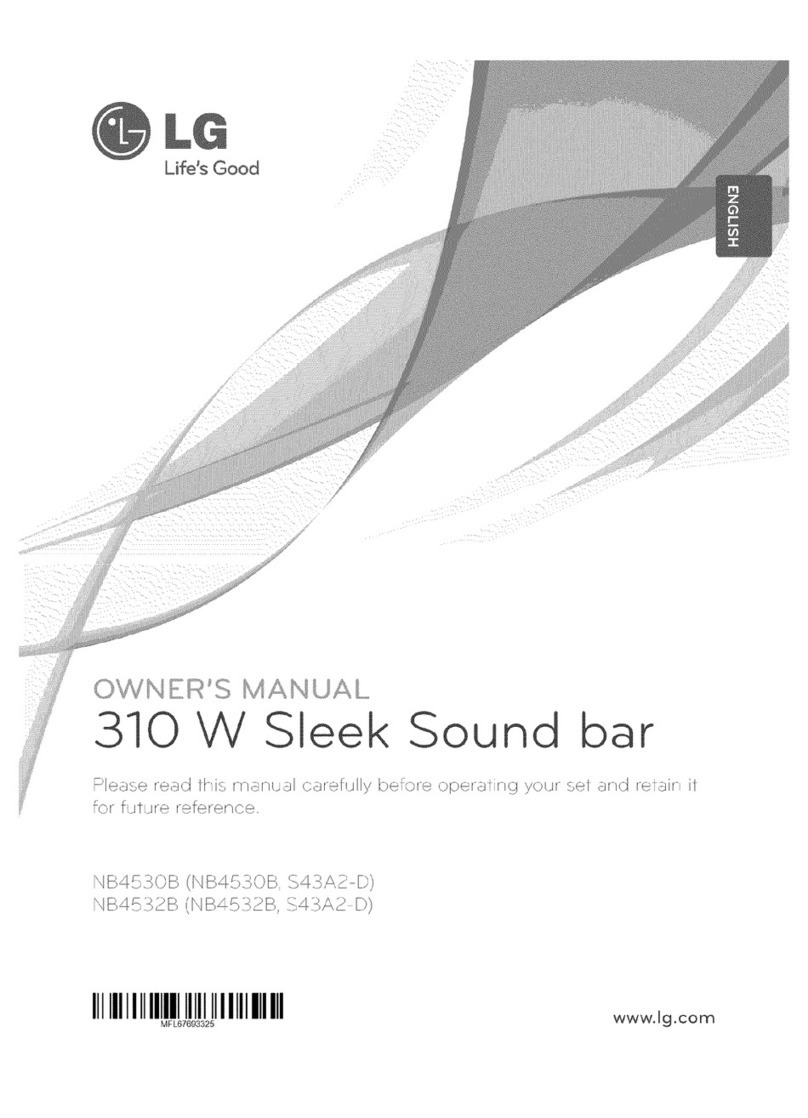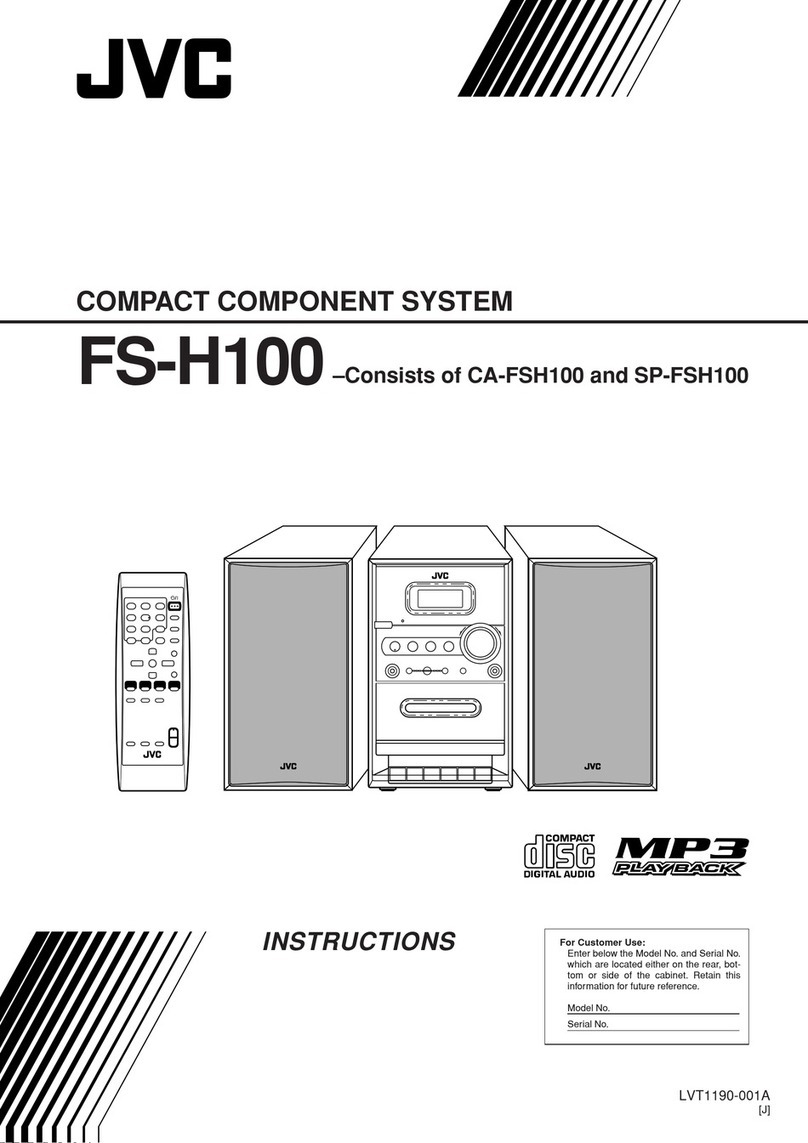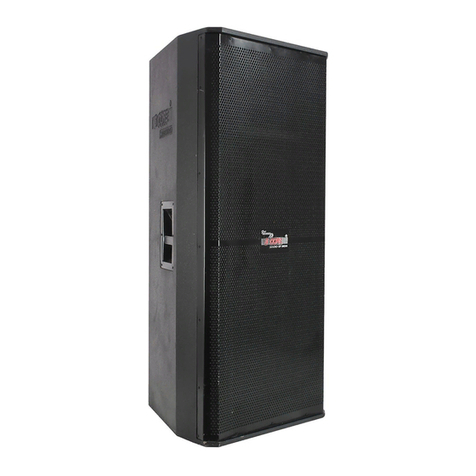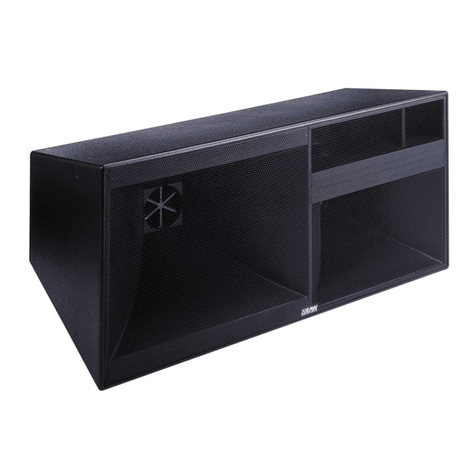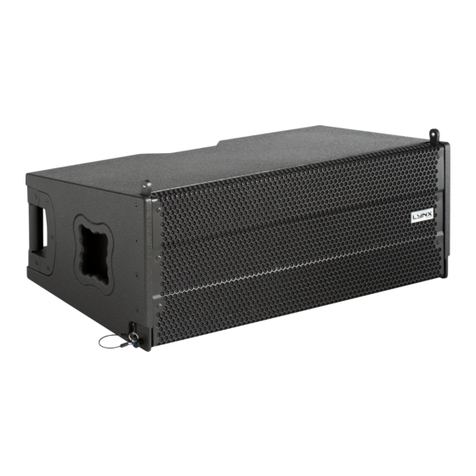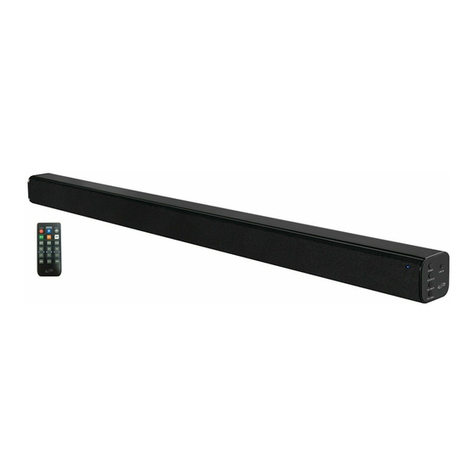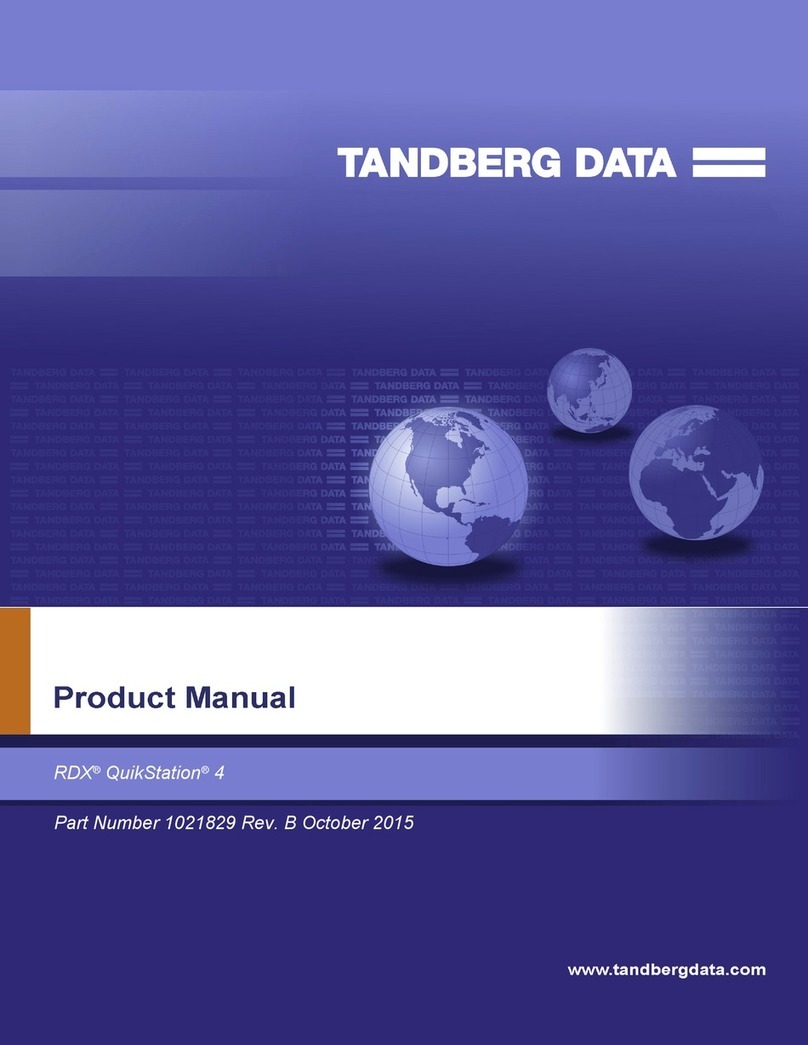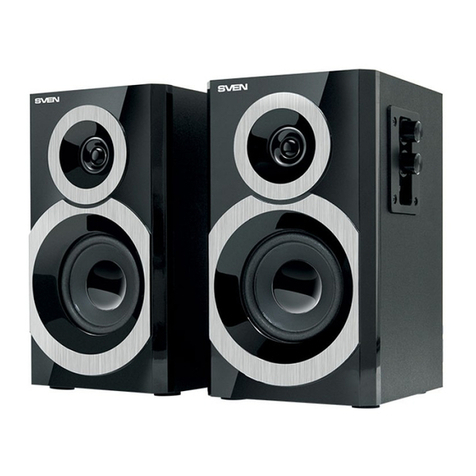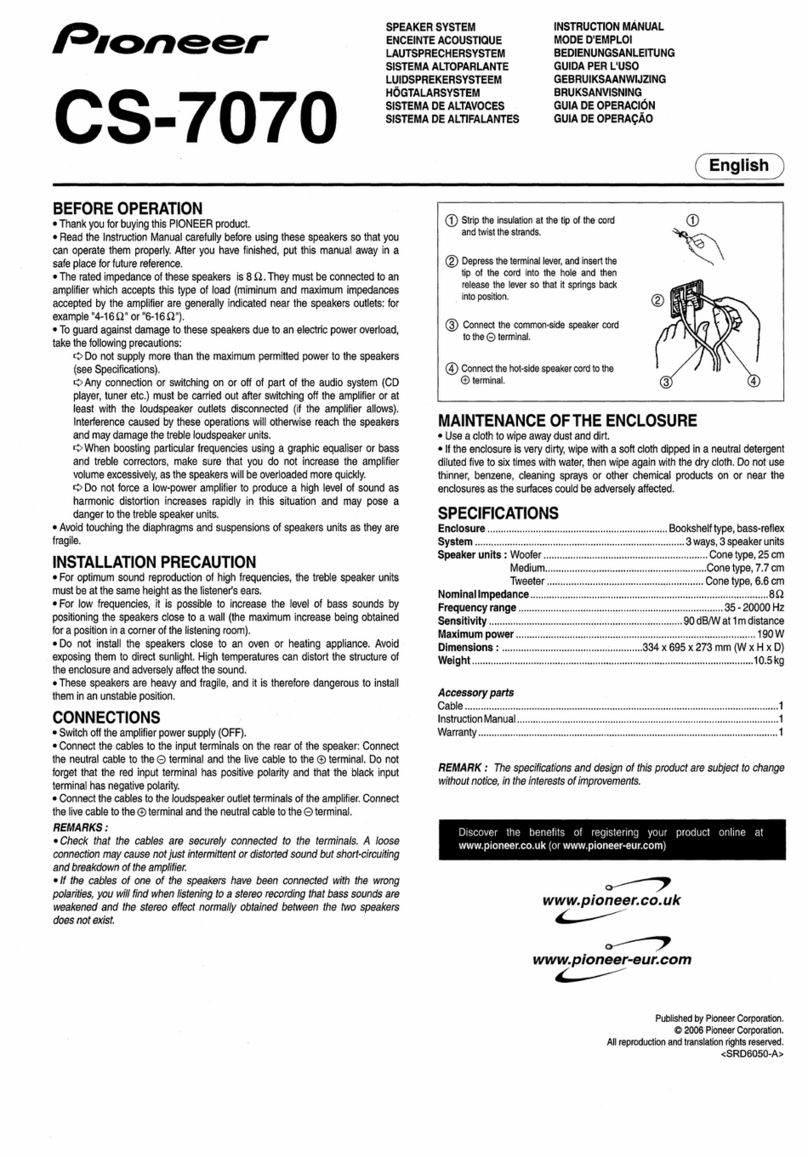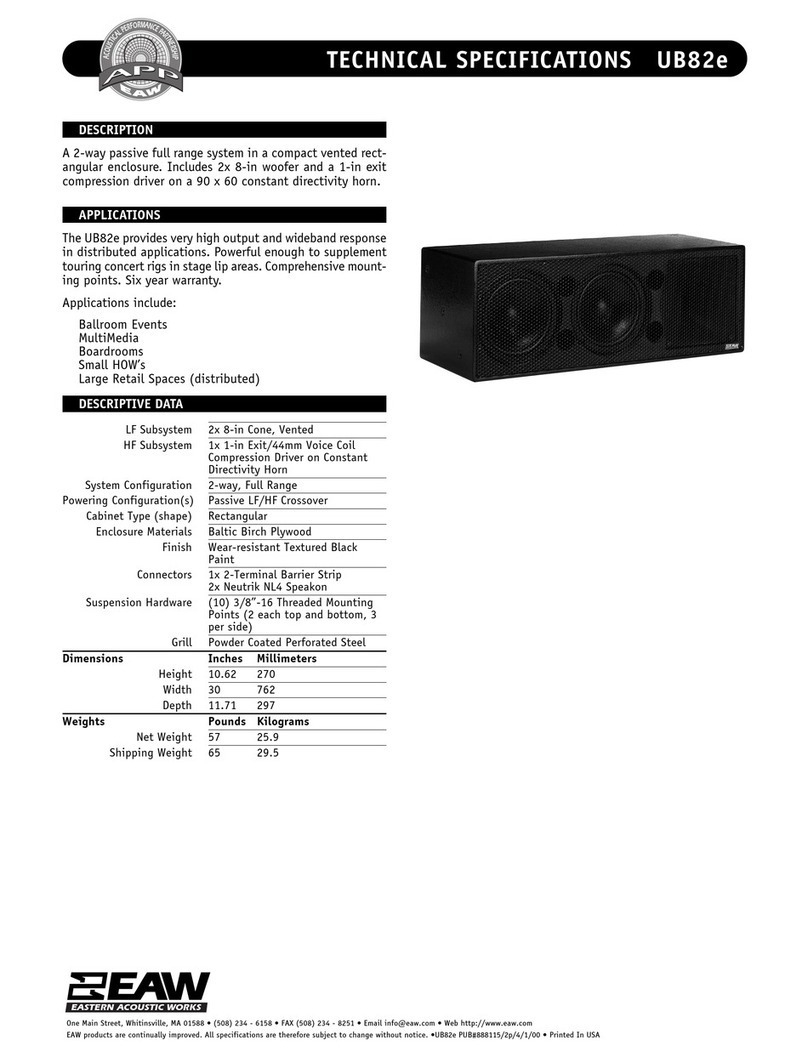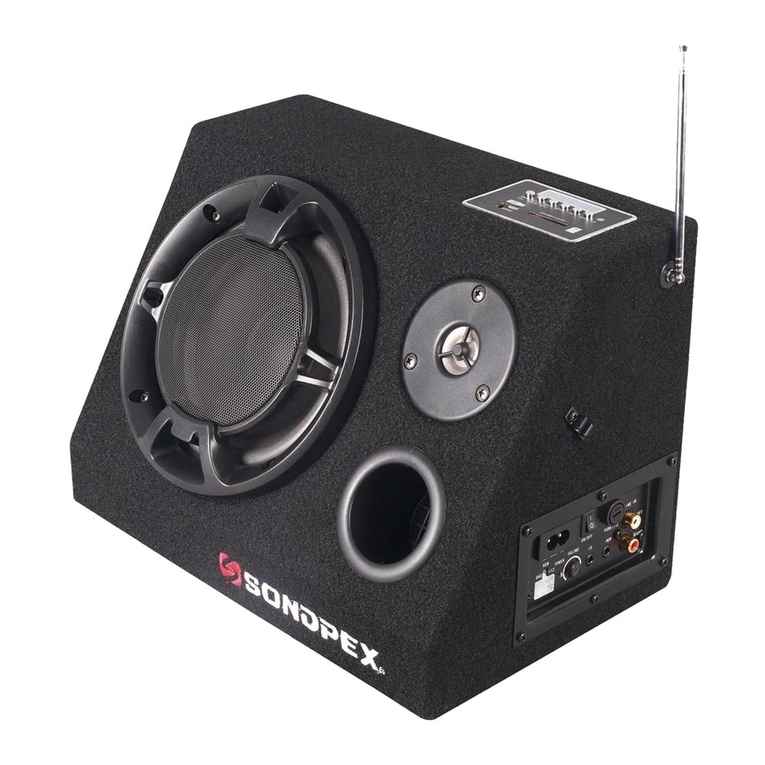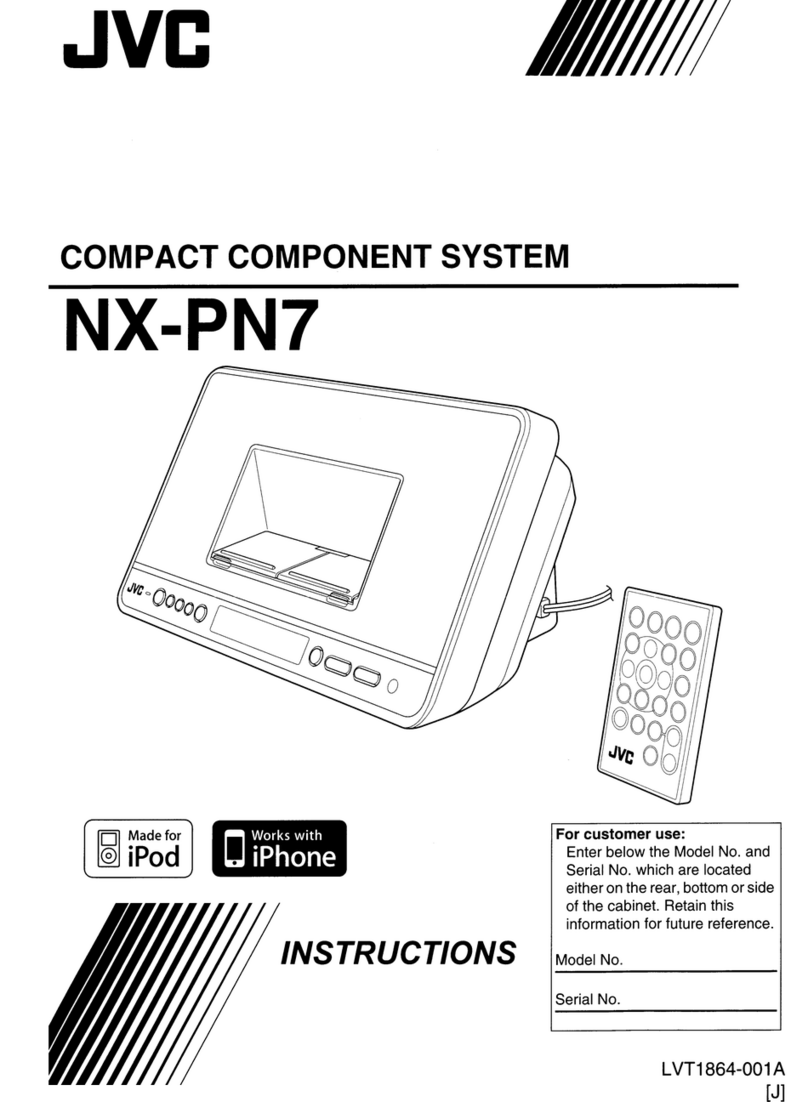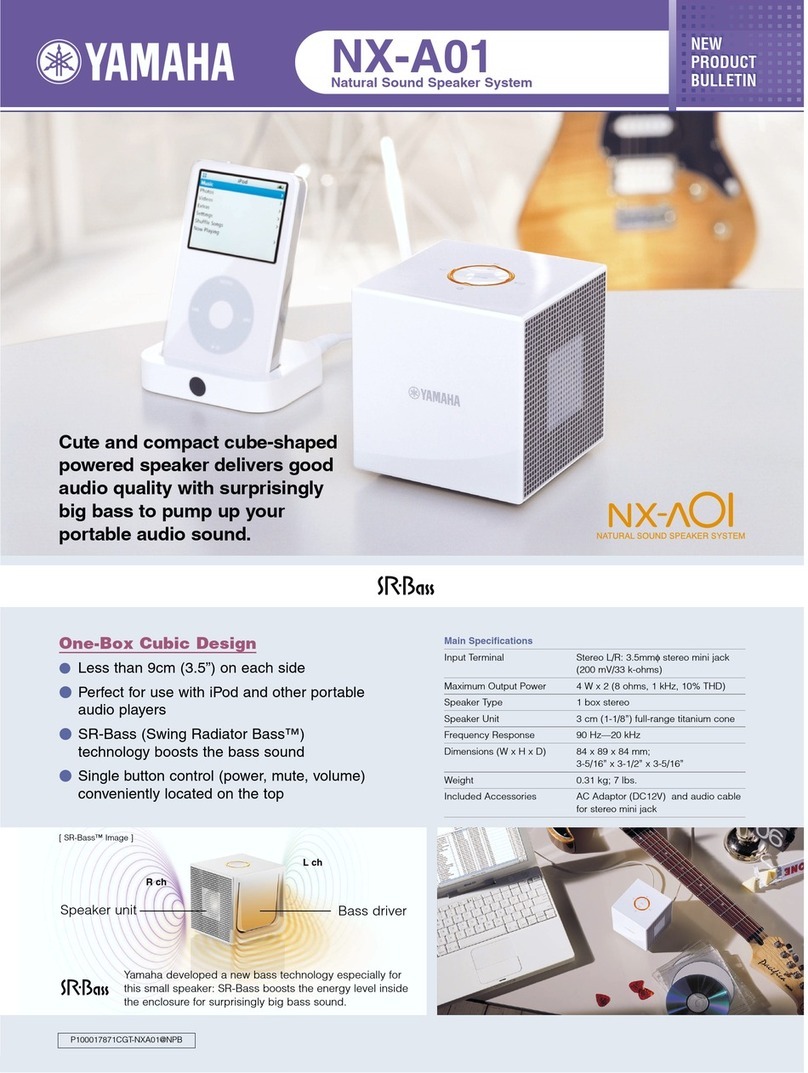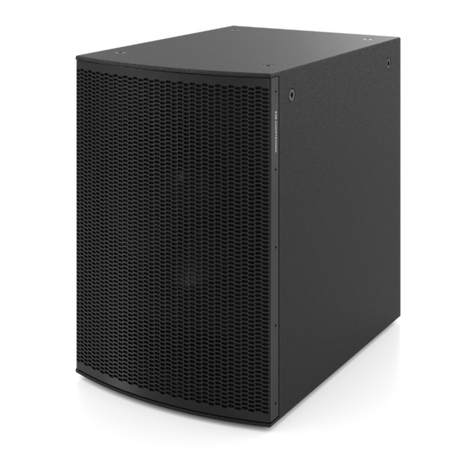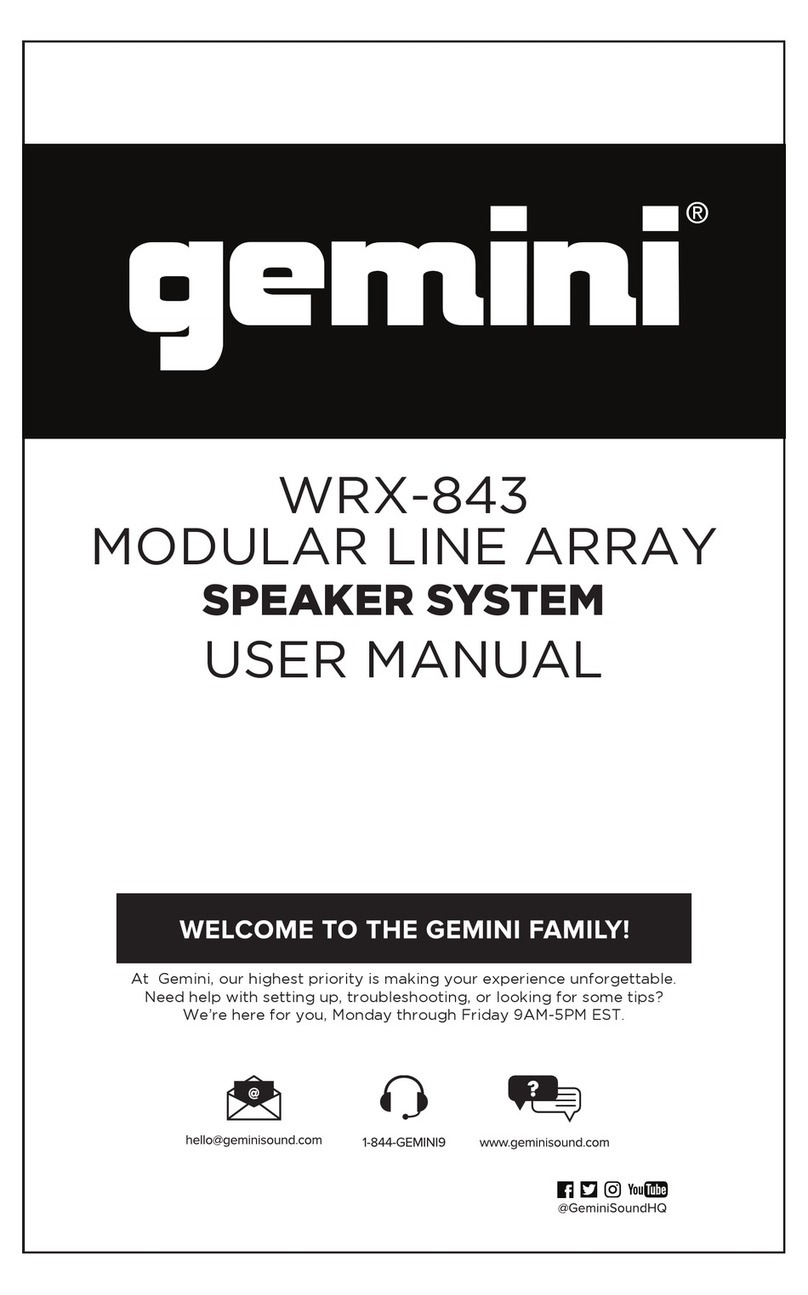Zestaw głośnikowy do samocho-
dowego systemu HiFi
1Zastosowanie
en wysokiej jakości zestaw głośnikowy został specjalnie
aprojektowany do stosowania w samochodowych syste-
mach HiFi. Zestaw składa się z:
2 x głośników niskośredniotonowych PREDATOR-6/4
2 x głośników wysokotonowych DT-284
2 x dwudrożnych zwrotnic CDN-2X
6 x śrub z gniazdem sześciokątnym do drewna 4 x 16 mm
MZF-8614
6 x śrub z gniazdem sześciokątnym do drewna 4 x 25 mm
MZF-8616
Moc znamionowa poszczególnych elementów wynosi
20 WRMS (250 WMAX) na kanał i nie może zostać przekro-
zona.
2Informacje dotyczące bezpieczeństwa
wrotnice i głośniki podlegają wytycznym i normom dla
rządzeń zgodnych z 89/336/EEC.
Urządzenia są przeznaczone tylko do użytku wewnątrz
pomieszczeń. Chroń przed wodą, wysoką wilgotnością i
wysoką temperaturą (dopuszczalny zakres temperatury
to 0 – 40 °C).
Do czyszczenia używać suchej, miękkiej ściereczki. Nie
stosować wody ani środków czyszczących.
Zestaw musi być zainstalowany fachowo w stabilnym
miejscu w samochodzie tak, aby poszczególne części
się nie poluzowały i nie stanowiły zagrożenia.
Producent ani dostawca nie ponosi odpowiedzialności
za wynikłe szkody materialne, jeśli urządzenie było
używane niezgodnie z przeznaczeniem, zostało zainsta-
lowane lub obsługiwane niepoprawnie lub poddawane
nieautoryzowanym naprawom.
3Połączenia i ustawienia
3.1 Połączenia
Połączenia głośników dla jednego kanału są pokazane na
rysunku poniżej. Połączenia dla drugiego kanału są iden-
tyczne.
Zaleca się stosowanie kabli głośnikowych np. z serii
SPC-… z oferty MONACOR. Należy zawsze przestrzegać
prawidłowej biegunowości.
1) Podłącz wyjście wzmacniacza mocy do wejścia IN
zwrotnicy.
2) Podłącz głośniki wysoko tonowe do końcówek TWEE-
TER. Biegun dodatni jest oznaczony “+”.
3) Podłącz głośnik niskośredniotonowych do końcówek
WOOFER 1 x 4 Ω. Biegun dodatni znajduje się na szers-
zym łączu.
3.2 Ustawienia
1) Za pomocą przełącznika X-OVER ustaw zwrotnicę tak,
aby otrzymać optymalny dźwięk:
6dB/oktawę lub 12 dB/oktawę.
Jeżeli głośniki wysoko i niskośredniotonowych z jedne-
go kanału są zamocowane blisko siebie (np. na tylnej
półce), najlepszym wyborem jest zazwyczaj ustawienie
12 dB/oktawę. Przy większej odległości (np. głośnik
niskośredniotonowych w drzwiach, wysokotonowy w
tylnim słupku) najlepszym wyborem jest zazwyczaj
ustawienie 6 dB/oktawę. Najlepiej sprawdzić jakość
dźwięku i zostawić najlepsze ustawienie.
2) Ustaw fazę za pomocą przełącznika TWEETER PHASE.
Wybierz takie ustawienie przełącznika, przy którym
średnie tony (około 2000 Hz) brzmią najlepiej.
3) Aby wyregulować wysokie częstotliwości użyj suwaka
TWEETER LEVEL. Wysokie częstotliwości są odpowied-
nio tłumione przy ustawieniach
-
3dBi
-
6dB.
Dla większości systemów optymalne odtwarzanie osiąga
się, kiedy ustawienia obydwu zwrotnic są takie same.
Nachylenie charakterystyki dla obydwu zwrotnic musi być
identyczne.
4 Dane techniczne
Dane ogólne
Impedancja: . . . . . . . . . . . . . . . 4 Ω
Pasmo przenoszenia: . . . . . . . f3–20000Hz
Moc znamionowa: . . . . . . . . . . 120 WRMS, 250 WMAX
SPL: . . . . . . . . . . . . . . . . . . . . . 90 dB przy 1W, 1 m
Dopuszczalna temp. pracy . . . 0 – 40 °C
Głośniki Głośnik Głośnik
niskośrednio- wysokoto-
tonowy nowy
Częstotliwość rezonansowa (fs): 66 Hz 1300 Hz
SPL (1 W/1 m): . . . . . . . . . . . . . 91 dB 91 dB
Podatność mechaniczna
zawieszeń (Cms): . . . . . . . . . . 0,47 mm/N
Masa ruchoma (Mms): . . . . . . 12,4 g
Dobroć mechaniczna (Qms): . 4,97
Dobroć elektryczna (Qes): . . . 0,45
Dobroć wypadkowa (Qts): . . . . 0,41
Objętość ekwiwalentna (Vas): . 10,6 l
Rezystancja (Re): . . . . . . . . . . . 3,15 Ω
Indukcyjność cewki (Le): . . . . . 0,4 mH
Średnica cewki: . . . . . . . . . . . . 25 mm 28 mm
Maksymalne wychylenie (XMAX): ±3,75 mm
Czynna powierzchnia
membrany (Sd): . . . . . . . . . . . . 127 mm2
Zwrotnica
Częstotliwość podziału: . . . . . . 2000 Hz
Nachylenie: . . . . . . . . . . . . . . . opcjonalnie 6 dB/oktawę lub
12 dB/oktawę
Może ulec zmianie.
Jeśli urządzenia nie będą już nigdy więcej
używane, wskazane jest przekazanie ich do
miejsca utylizacji odpadów, aby zostały utylizo-
wane bez szkody dla środowiska.
Sistema de altavoces empotrados
para car audio
1Posibilidades de utilización
ste conjunto de altavoces de alta calidad está especial-
mente fabricado para una utilización en instalaciones de car
udio y se compone de:
2 x altavoces de grave-medio PREDATOR-6/4
2 x altavoces de agudo DT-284
2 x filtros 2 vías CDN-2X
6 x tornillos hexagonales para madera 4 x 16 mm MZF-8614
6 x tornillos hexagonales para madera 4 x 25 mm MZF-8616
a capacidad de carga de los componentes es de 120 WRMS
250 WMAX) por canal y no puede sobrepasarse.
2Consejos de seguridad y utilización
os filtros y los altavoces cumplen con la normativa europea
9/336/CEE relativa a la compatibilidad electromagnética.
Los componentes solamente están concebidos para una
utilización en interior. Protéjalos de todo tipo de salpica-
duras, de todo tipo de proyecciones de agua, una hume-
dad elevada y del calor (temperatura ambiente admisible
0–40°C).
Para limpiarlo, utilice un trapo seco y suave, en ningún
caso productos químicos o agua.
Los componentes deben instalarse de manera fija y pro-
fesional en un lugar mecánicamente estable dentro del
vehículo para evitar que se desenrosquen y se transfor-
men en un proyectil peligroso.
Declinamos toda responsabilidad en caso de daños cor-
porales o materiales resultantes de la utilización de los
componentes con otra finalidad para la cual han sido con-
cebidos, si no están conectados correctamente, si hay una
sobrecarga o si no han sido reparados por una persona
habilitada; además, carecerían de todo tipo de garantía.
3Funcionamiento
3.1 Conexión
El esquema siguiente presenta la conexión de los altavoces
para un canal. La conexión para el segundo canal es idéntica.
Se recomienda utilizar, como cable de conexión, cables
de altavoces con un conductor marcado, p. ej. de la serie
SPC-… de MONACOR. Conecte siempre el conductor mar-
cado al polo correspondiente para evitar toda inversión de
polaridad.
1) Conecte la salida del amplificador en la entrada IN del fil-
tro.
2) Conecte el altavoz de agudo a los bornes TWEETER. El
polo positivo está marcado con un “+”.
3) Conecte a los bornes WOOFER 1 x 4 Ωel altavoz de
grave-medio. El contacto de conexión más grande es el
polo positivo.
3.2 Ajustes
1) Con el interruptor X-OVER, ajuste la pendiente del filtro
según la tonalidad óptima:
6dB/octavo o 12 dB/octavo.
Si el altavoz de agudo y el altavoz de grave-medio para
un canal están montados en proximidad el uno con el
otro (p. ej. juntos en la parte trasera), una pendiente de
12 dB/octavo es generalmente mejor. Si la distancia es
más grande (p. ej. altavoz de grave-medio en la parte
inferior de la puerta y altavoz de agudo en el cristal trian-
gular), un ajuste de 6 dB/octavo puede dar una mejor
tonalidad. Finalmente, siempre es la mejor restitución
que es decisiva para el ajuste.
2) Con el interruptor TWEETER PHASE, ajuste la fase. Se-
leccione la posición del interruptor para que las frecuen-
cias de medios (2000 Hz más o menos) tengan la mejor
tonalidad.
3) Para una adaptación de agudos, utilice el potenciómetro
deslizante TWEETER LEVEL. En posición
-
3dB y
-
6dB,
las frecuencias agudas se disminuyen en consecuencia.
En la mayoría de las instalaciones, obtenemos una restitu-
ción óptima si los interruptores de los dos filtros están en la
misma posición. En todo caso, es necesario que el ajuste de
la pendiente sea idéntico para los dos filtros.
4Características técnicas
Informaciones generales
Impedancia: . . . . . . . . . . . . . . . . 4 Ω
Banda pasante: . . . . . . . . . . . . . f3–20000 Hz
Potencia: . . . . . . . . . . . . . . . . . . . 120 WRMS, 250 WMAX
Presión sonora media: . . . . . . . . 90 dB a 1 W, 1 m
Temperatura func.: . . . . . . . . . . . 0 – 40 °C
Altavoces Altavoz de Altavoz de
grave-medio agudo
Frecuencia de resonancia (fs): . . 66 Hz 1300 Hz
Presión sonora media (1 W/1 m): . 91 dB 91 dB
Pliegue suspensión (Cms): . . . . . 0,47 mm/N
Masa móvil (Mms): . . . . . . . . . . . 12,4 g
Sobretensión mecánica (Qms): . 4,97
Sobretensión eléctrica (Qes): . . . 0,45
Factor de sobretensión total (Qts): 0,41
Volumen equivalente (Vas): . . . . 10,6 l
Resistencia DC (Re): . . . . . . . . . 3,15 Ω
Inductancia bobina (Le): . . . . . . . 0,4 mH
Diámetro bobina: . . . . . . . . . . . . 25 mm 28 mm
Excursión lineal (XMAX): . . . . . . . ±3,75 mm
Superficie de emisión (Sd): . . . . 127 mm2
Filtro
Frecuencia de corte: . . . . . . . . . . 2000 Hz
Pendiente: . . . . . . . . . . . . . . . . . conmutable 6 ou12 dB/ oct
Nos reservamos todo derecho de modificación.
Cuando los componentes estén definitivamente
retirados del servicio, debe depositarlos en una
fábrica de reciclaje próxima para contribuir a su
eliminación no contaminante.
Copyright©by MONACOR INTERNATIONAL GmbH & Co. KG, Bremen, Germany. All rights reserved. www.carpower.com A-0391.99.01.03.2005
®
2-WAY CAR HIFI
SPEAKER SYSTEM PRESET-1
Best.-Nr. 13.1650
.
.
.
.
.
.

